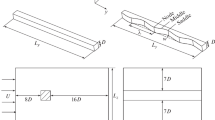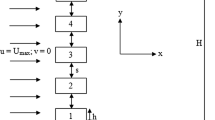Abstract
The aerodynamic forces on a wall-mounted finite-length square cylinder are experimentally investigated. The width of the tested model d = 200 mm, and the aspect ratio H/d = 5. The oncoming flow velocity U ∞ = 13 m/s, corresponding to a Reynolds number of 1.73 × 105 based on U ∞ and d. It is found that the time-averaged drag coefficient \( \overline{{C_{D} }} \) and rms value of lift coefficient \( C^\prime_{L} \) of the finite-length cylinder are both smaller than those of 2D square cylinder. Two typical flow modes occur in the flow around the finite-length cylinder: Mode 1 is characterized by alternating spanwise vortex shedding, corresponding to a higher drag and large amplitude fluctuation of lift; Mode 2 is characterized by symmetrical vortex shedding, corresponding to a lower drag and the lift without periodic fluctuation. At the lower part of cylinder, \( C^\prime_{L} \) of Mode 1 is about one times larger than that of Mode 2, this difference reduces gradually with approaching to the free end. The spanwise correlation of aerodynamic force is stronger in Mode 1.
Financial support from the NSFC 11472312, 51108468 is acknowledged.
Access provided by Autonomous University of Puebla. Download conference paper PDF
Similar content being viewed by others
Keywords
These keywords were added by machine and not by the authors. This process is experimental and the keywords may be updated as the learning algorithm improves.
1 Introduction
Finite-length cylinders with one end mounted on a flat wall and the other free are frequently encountered in engineering applications, such as chimneys, cooling towers and high-rise buildings. Under the effects of boundary layer on the wall and cylinder free end, the flow around a finite-length cylinder is highly three dimensional and drastically different from that of a 2D cylinder (Wang and Zhou 2009). In the finite-length cylinder wake, there is a pair of streamwise vortices near the free end, i.e. tip vortices, which induces strong downwash flow. There will be a pair of base vortices, if the thickness on the boundary layer is large enough, which results in an upwash flow in the cylinder near wake (Summer et al. 2004; Wang et al. 2006). Under the effects of both tip vortices and base vortices, the spanwise vortices in the finite-length cylinder wake are weakened relative to those in 2D cylinder wake. Furthermore, the width of the near wake of finite-length cylinder is larger and its vortex shedding frequency is lower relative to that of 2D cylinder (Wang and Zhou 2009).
Both the time-averaged drag coefficient \( \overline{{C_{D} }} \) and fluctuation lift coefficient \( C_{L}^{{\prime }} \) of finite-length cylinder are significantly smaller than those of 2D cylinder (Fox and West 1993). Moreover, the \( \overline{{C_{D} }} \) reduces gradually with decreasing cylinder aspect ratio, H/d, where H is the cylinder height and d is its characteristic width (Okamoto and Sunabashiri 1992). Since the flow around a finite-length cylinder is high three dimensional, the aerodynamics on it are different at various spanwise positions.
Two typical instantaneous flow modes can be identified in the near wake of a finite-length cylinder based on its near wake experimental results for a finite-length square cylinder with H/d = 4 and 7 (Wang and Zhou 2009; Bourgeois et al. 2011). Mode 1 is characterized by alternating larger scale spanwise vortices, similar to that in 2D cylinder wake; on the other hand, Mode 2 is dominated by symmetrical spanwise vortices. The two typical modes occur randomly, which must have significant effects on the aerodyanmics forces on the finite-length cylinder.
2 Experimental Details
Experiments were conducted in a closed-loop wind tunnel in Central South University, with a low speed test section of 12 m (width) × 3.5 m (height) × 18 m (length) and a high speed test section of 3 m (width) × 3 m (height) × 15 m (length), respectively. The present experiments were performed in the high speed section.
A finite-length square cylinder with d = 200 mm and H/d = 5 was mounted on the wind tunnel bottom wall, as shown in Fig. 1a. The oncoming velocity U ∞ = 13 m/s, corresponding to Re = 1.73 × 105. Pressure taps were arranged at four spanwise positions, i.e. z * = 1, 2.5, 4 and 4.5. The superscript ‘*’ in the present paper indicates normalization with U ∞ and d. All pressure taps were connected to a pressure scanner. For each tap, 20,000 instantaneous samples were measuremed at a frequency of 625 Hz. Measurements were also conducted for a 2D square cylinder at the same Re for comparison. The boundary layer was documented with a Cobra probe prior to the installation of cylinder. As shown in Fig. 1b, the thickness of boundary layer on the wind tunnel wall is about 200 mm, that is most of the tested cylinder is in uniform oncoming flow, except z * < 1.
The time-averaged pressure coefficient \(\overline{{C_{p} }} = (\overline{P} - P_{\infty } )/{0.5}\rho U_{\infty }^{2} \), and the rms value of pressure coefficient \( C_{p\_rms} = {{p_{rms}}/{0.5\rho U_{\infty }^{2} }} \), respectively. In which, \( \overline{P} \) is the time-averaged pressure, p rms is the rms value of fluctuation pressure, p ∞ is the static pressure in the wind tunnel.
3 Results and Discussion
3.1 Time Averaged Results
Figure 2 presents the distribution of \( \overline{{C_{p} }} \) and C p_rms for both finite length and 2D square cylinder. It can be inferred from Fig. 2 that the \( \overline{{C_{D} }} \) and \( C_{L}^{{\prime }} \) of finite-length cylinder is smaller than those of 2D cylinder. At the windward face (A), \( \overline{{C_{p} }} \) is quite similar at all spanwise positions, and in line with that of 2D cylinder. On the other hand, the \( \overline{{C_{p} }} \) on the side faces (B and D) and the leeward face (C) is higher than those of 2D cyinder and quite different at various z *, i.e., its absolute magnitude is relatively larger near cylinder free end.
For a 2D cylinder, the C p_rms presents the its minimal value at the front stagnation point, and increases quickly with approaching to the side edges. The C p_rms on faces B, D and C is siginificantly larger than that of the cylinder with H/d = 5, which may be ascribed to the fact that the spanwise vortex shedding is suppressed in finite-length cylinder wake. The C p_rms at the lower part of the cylinder is relatively larger than that near the cylinder free end, suggesting the suppression of spanwise vortex is more remarkable near cylinder free end under the effects of tip vortices.
3.2 Instantaneous Results
Figure 3 presents the instantaneous C D and C L of the finite-length square cylinder and 2D one. The instantaneous pressure coefficients at the centers of both side faces at cylinder midspan, i.e., C p_l and C p_r , are also shown. For the 2D cylinder, C L presents continues periodic fluctuation, and C D also fluctuates with a frequency of twice of that of C L . For the cylinder with H/d = 5, the fluctuation of C L is not continues. This observation should be ascribed to the intermittency of antisymmetrical spanwise vortex shedding, in line with the randomly occurred two typical modes in finite-length cylinder wake (Wang and Zhou 2009; Bourgeois et al. 2011). When antisymmetrical spanwise vortices (Mode 1) occurs, C L presents periodic fluctuation and the corresponding C D is relatively larger (1.5–2.5 s); on the other hand, when symmetrical vortices (Mode 2) occurs, C L has no clear periodicity (2.7–3.5 s). For the 2D cylinder, C p_l and C p_r always are opposite in phase and bear large amplitude fluctuation. For the cylinder with H/d = 5, C p_l and C p_r are opposite in phase and fluctuate periodicly when Mode 1 occurs, similar to that for 2D cylinder. On the other hand, C p_l and C p_r do not fluctuate periodicly and have no clear phase relation when Mode 2 occurs, as shown in Fig. 3.
3.3 Conditional Averaged Results
In following analysis, we defined the C L with fluctuation amplitude larger than \( 1.1\,C_{L}^{{\prime }} \) as Mode 1, otherwise as Mode 2. This criteria was visually chosen so that most large amplitude fluctuation in C L can be identified as Mode 1. Figure 4 gives the conditional averaged \( \overline{{C_{D} }} \) and \( C_{L}^{{\prime }} \) and also spanwise correlation coefficient R of fluctuation pressure. As shown in Fig. 4, \( \overline{{C_{D} }} \) of the two typical modes are quite similar, though \( \overline{{C_{D} }} \) of Mode 1 is slightly larger than that of Mode 2. On the other hand, the difference of \( C_{L}^{{\prime }} \) between the two modes is much more significant, especially at the lower part of cylinder. At z * = 1, 2.5, 4 and 4.5, \( C_{L}^{{\prime }} \) of Mode 1 is 138, 98, 81 and 65 % larger than that of Mode 2. Under the effects of tip vortices, the difference of \( C_{L}^{{\prime }} \) between the two modes reduces gradually with free end approached.
It is also interesting to examine the spanwise correlation of the aerodynamic forces. The reference point is fixed at z * = 1, as shown in Fig. 4. The correlation coefficient R can be determined between the reference point and a moveable point along cylinder span. The spanwise correlation of Mode 1 is also much stronger than that of Mode 2, although both are obviously weaker than that of 2D cylinder.
4 Conclusions
For a finite-length square cylinder in smooth uniform flow, its aerodynamic forces are much smaller than those of 2D cylinder. Two typical modes exist in its near wake. When spanwise vortices are antisymmetrical, i.e. Mode 1, C L presents large amplitude periodic fluctuation; when symmetrical vortices occur, i.e. Mode 2, C L has no obvious periodicity and its fluctuation amplitude is limited. The spanwise correlation of aerodynamic forces in Mode 1 is also significantly stronger than that in Mode 2. Under the effects of tip vortices near cylinder free end, the difference of aerodynamic forces between the two typical modes become less obvious with free end approached.
References
Bourgeois JA, Sattari P, Martinuzzi RJ (2011) Alternating half-loop shedding in the turbulent wake of a finite surface-mounted square cylinder with a thin boundary layer. Phy Fluid 23:095101
Fox TA, West GS (1993) Fluid induced loading of cantilevered circular cylinders in low turbulent uniform flow. Part 2: fluctuating loads with aspect ratios 4 to 25. J Fluid Struct 7:375–386
Okamoto T, Sunabashiri Y (1992) Vortex shedding from a circular cylinder of finite length placed on a ground plane. J Fluid Eng 114:512–521
Summer D, Heseltine JL, Dansereau OJP (2004) Wake structure of a finite circular cylinder of small aspect ratio. Exp Fluids 37:720–730
Wang HF, Zhou Y (2009) The finite-length square cylinder near wake. J Fluid Mech 638:453–490
Wang HF, Zhou Y, Chan CK, Lam KS (2006) Effect of initial conditions on interaction between a boundary layer and a wall-mounted finite-length-cylinder wake. Phy Fluids 18:065106
Author information
Authors and Affiliations
Corresponding author
Editor information
Editors and Affiliations
Rights and permissions
Copyright information
© 2016 Springer-Verlag Berlin Heidelberg
About this paper
Cite this paper
Wang, H.F., Zou, C., Zhang, Y.P. (2016). Vortex Shedding Intermittency and Its Effects on the Aerodynamics Forces of a Finite-Length Square Cylinder. In: Zhou, Y., Lucey, A., Liu, Y., Huang, L. (eds) Fluid-Structure-Sound Interactions and Control. Lecture Notes in Mechanical Engineering. Springer, Berlin, Heidelberg. https://doi.org/10.1007/978-3-662-48868-3_66
Download citation
DOI: https://doi.org/10.1007/978-3-662-48868-3_66
Published:
Publisher Name: Springer, Berlin, Heidelberg
Print ISBN: 978-3-662-48866-9
Online ISBN: 978-3-662-48868-3
eBook Packages: EngineeringEngineering (R0)








